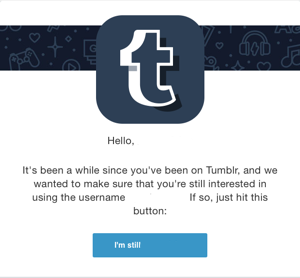Confirmed Opt-In
GDPR and the EU and Opt-in Confirmation
There’s a lot of discussion going on about just what GDPR requires, and of who, and in which jurisdictions. German organizations in particular have been more aggressive than most about wanting to see opt-in confirmation for years and now seem to be adding “because GDPR” to their arguments.
I’m still not sure how this is going to shake out, but I’m beginning to see list owners take externally visible action.
I’ve been a subscriber for four or five years – it’s a good mailing list, run well, and I doubt it has any delivery issues beyond the unavoidable.
So this is a permission pass solely because they’re not sure whether I’m an EU resident, and aren’t 100% sure their opt-in confirmation data is squeaky clean (I subscribed as part of downloading an app of theirs, but after five years I couldn’t tell you whether that was technically confirmed opt-in or not, and I’m sure they can’t either).
Zoomdata aren’t taking any chances on confirmation. This isn’t a single “click to confirm you want to stay on the list” permission pass, rather it goes to a form that asks whether I’m an EU resident and if I am requires me to check an “Opt-in to email communications” checkbox and then click on a link in a confirmation email.
I’m not an EU resident today but may be an EU resident in the near future – yet my email address won’t change and nor will my mailing list subscriptions. That does make me wonder how valid it is to be capturing opt-in permission solely for recipients who are EU residents today.
Also are non-EU residents likely to claim they live in the EU because they’ll be treated better as far as their privacy is concerned, much the same as telling Facebook or Twitter you live in Germany provides you with better content filters?
I guess I’ll be seeing more of this in my inbox over the next few weeks. How are all y’all handling GDPR compliance?
Confirmed Opt-In: An Old Topic Resurrected
Looking back through my archives it’s been about 4 years or so since I wrote about confirmed opt in. The last post was how COI wasn’t important, but making sure you were reaching the right person was important. Of course, I’ve also written about confirmed opt-in in general and how it was a tool somewhat akin to a sledgehammer. I’m inspired to write about it today because it’s been a topic of discussion on multiple mailing lists today and I’ve already written a bunch about it (cut-n-paste-n-edit blog post! win!).
Confirmed opt-in is the process where you send an email to a recipient and ask them to click on a link to confirm they want the mail. It’s also called double opt-in, although there are some folks who think that’s “spammer” terminology. It’s not, but that’s a story for another day. The question we were discussing was what to do with the addresses that don’t click. Can you email them? Should you email them? Is there still value in them?
We have to treat the addresses as a non-homogenous pool. There are a lot of reasons confirmation links don’t get clicked.
Tumblr Confirming Usernames
Today I received an email from Tumblr asking to confirm I still wanted the username I have there. I’ve not really been using Tumblr, I contributed a few things to the now-defunct Box of Meat, but I don’t really post there much.
I think this kind of engagement is great. Confirming user names will do a whole lot to allow Tumblr to release some claimed but unused names back into the pool. It will also actually help their deliverability and their engagement. If people do want to keep their tumblr names, then they have to click on the message. This means more clicks and better engagement and an overall reputation boost for Tumblr mail.
Confirmation is too hard…
One of the biggest arguments against confirmation is that it’s too hard and that there is too much drop off from subscribers. In other words, recipients don’t want to confirm because it’s too much work on their part.
I don’t actually think it’s too much work for recipients. In fact, when a sender has something the recipient wants then they will confirm.
A couple years ago I was troubleshooting a problem. One of my client’s customer was seeing a huge percentage of 550 errors and I was tasked with finding out what they were doing. The first step was identifying the source of the email addresses. Turns out the customer was a Facebook app developer and all the addresses (so he told me) were from users who had installed his apps on Facebook. I did my own tests and couldn’t install any applications without confirming my email address.
Every Facebook user that has installed an application has clicked on an email to confirm they can receive email at the address they supplied Facebook. There are over 1 billion users on Facebook.
Clicking a link isn’t too hard for people who want your content. I hear naysayers who talk about “too hard” and “too much drop off” but what they’re really saying is “what I’m doing isn’t compelling enough for users to go find the confirmation email.”
This isn’t to say everyone who has a high drop off of confirmations is sending poor content. There are some senders that have a lot of fake, poor or otherwise fraudulent addresses entered into their forms. In many cases this is the driving factor for them using COI: to stop people from using their email to harass third parties. Using COI in these cases is a matter of self protection. If they didn’t use COI, they’d have a lot of complaints, traps and delivery problems.
The next time you hear confirmation is too hard, remember that over 1 billion people, including grandparents and the technologically challenged, managed to click that link to confirm their Facebook account. Sure, they wanted what Facebook was offering, but that just tells us that if they want it bad enough they’ll figure out how to confirm.
HT: Spamresource
Confirmation Fails
Yesterday I talked about registration confirmations. Today I’m going to talk about a couple recent experiences with websites and their registration failures.
The first experience was with Yelp. One of my readers decided I needed a Yelp account and created one using my laura-questions email address. Yelp understands that people will be jerks and so sent me an email to confirm the account.
Confirming addresses in the wild
A lot of marketers tell me “no sender confirms addresses” or “confirming addresses is too hard for the average subscriber.” I find both these arguments difficult to accept. Just today I subscribed to a mailing list that had a confirmation step. The subscription form was pretty simple.